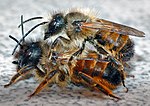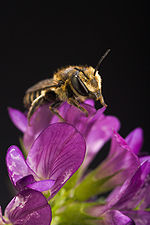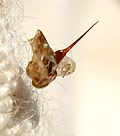Diseases of the honey bee or abnormal hive conditions include: Varroa destructor and V. jacobsoni are parasitic mites that feed on the fat bodies of adult... 66 KB (7,646 words) - 10:28, 15 April 2024 |
The following are lists of animal diseases: List of aquarium diseases List of dog diseases List of feline diseases List of diseases of the honey bee List... 606 bytes (67 words) - 11:28, 2 February 2024 |
 | than honey bees, particularly the European honey bee (Apis mellifera). Worker bees of this variety are responsible for approximately 80% of the world's... 21 KB (2,617 words) - 19:30, 14 April 2024 |
 | honey bee (also spelled honeybee) is a eusocial flying insect within the genus Apis of the bee clade, all native to mainland Afro-Eurasia. After bees... 95 KB (11,254 words) - 03:41, 8 May 2024 |
Beekeeping (redirect from Bee-keeping) is the maintenance of bee colonies, commonly in man-made beehives. Honey bees in the genus Apis are the most commonly kept species but other honey producing... 88 KB (9,840 words) - 21:21, 7 May 2024 |
 | Mason bee is a name now commonly used for species of bees in the genus Osmia, of the family Megachilidae. Mason bees are named for their habit of using... 14 KB (1,639 words) - 01:20, 24 August 2023 |
 | Honey is a sweet and viscous substance made by several species of bees, the best-known of which are honey bees. Honey is made and stored to nourish bee... 115 KB (12,885 words) - 12:26, 23 April 2024 |
 | The Apis mellifera mellifera (commonly known as the European dark bee) is a subspecies of the western honey bee, evolving in central Asia, with a proposed... 49 KB (5,696 words) - 23:04, 4 April 2024 |
 | Apitherapy (redirect from Honey for multiple sclerosis) Apitherapy is a branch of alternative medicine that uses honey bee products, including honey, pollen, propolis, royal jelly and bee venom. There has been... 11 KB (1,149 words) - 16:46, 7 February 2024 |
The Buckfast bee is a breed of honey bee, a cross of many subspecies and their strains, developed by Brother Adam (born Karl Kehrle in 1898 in Germany)... 20 KB (2,620 words) - 10:51, 16 April 2024 |
Nosema apis (category Western honey bee pests) affects honey bees. It causes nosemosis, also called nosema, which is the most common and widespread of adult honey bee diseases. The dormant stage of N. apis... 19 KB (2,288 words) - 22:52, 10 January 2024 |
Honeybee starvation (redirect from Honey bee starvation) Honey bee starvation is a problem for bees and beekeepers. Starvation may be caused by unfavorable weather, disease, long distance transportation or depleting... 13 KB (1,592 words) - 11:18, 13 January 2024 |
and bee venom. Bee – a member of the order that includes ants and wasps Bee anatomy (mouth) Bee bread – the main source of food for most honey bees and... 4 KB (491 words) - 14:19, 5 September 2023 |
 | Apis andreniformis (redirect from Black dwarf honey bee) andreniformis, or the black dwarf honey bee, is a relatively rare species of honey bee whose native habitat is the tropical and subtropical regions of Southeast... 18 KB (2,266 words) - 20:30, 13 January 2024 |
 | The honey badger (Mellivora capensis), also known as the ratel (/ˈrɑːtəl/ or /ˈreɪtəl/), is a mammal widely distributed in Africa, Southwest Asia, and... 30 KB (2,972 words) - 06:06, 30 March 2024 |
 | The California carpenter bee or Western carpenter bee, Xylocopa californica, is a species of carpenter bee in the order Hymenoptera, and it is native... 12 KB (1,411 words) - 15:24, 23 April 2024 |
Within biological taxonomy, a honey bee race would be an informal rank in the taxonomic hierarchy, below the level of subspecies. It has been used as... 9 KB (984 words) - 05:35, 23 September 2023 |
Apis mellifera iberiensis (category Western honey bee breeds) mellifera iberiensis, or the Spanish bee, is a western honey bee subspecies native to the Iberian Peninsula. It is also found on the Balearic Islands. This... 11 KB (1,290 words) - 16:15, 2 July 2023 |
Apitoxin or bee venom is the venom produced by the honey bee. It is a cytotoxic and hemotoxic bitter colorless liquid containing proteins, which may produce... 5 KB (480 words) - 21:49, 8 August 2023 |
 | Megachile rotundata (redirect from Alfalfa leafcutter bee) half as painful as a honey bee's. Megachile rotundata is a member of the subfamily Megachilinae, which includes more than 4,000 bee species; this currently... 30 KB (3,625 words) - 22:24, 13 January 2024 |
 | Black queen cell virus (category Bee diseases) The black queen cell virus (BQCV) is a virus that infects honey bees, specifically Apis mellifera, Apis florea, and Apis dorsata. Infection of the latter... 14 KB (1,847 words) - 21:11, 2 January 2024 |
can kill bees directly, or make them more susceptible to other impacts like disease and climate change. Honey Nut Cheerios and Burt's Bees joined together... 13 KB (923 words) - 20:05, 27 September 2023 |








